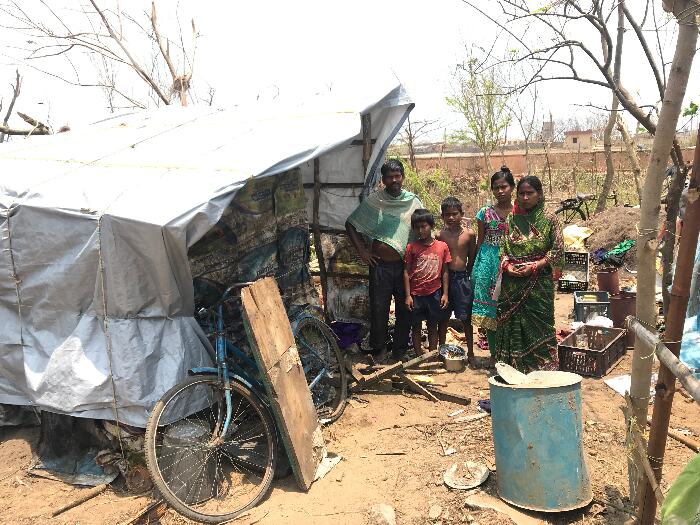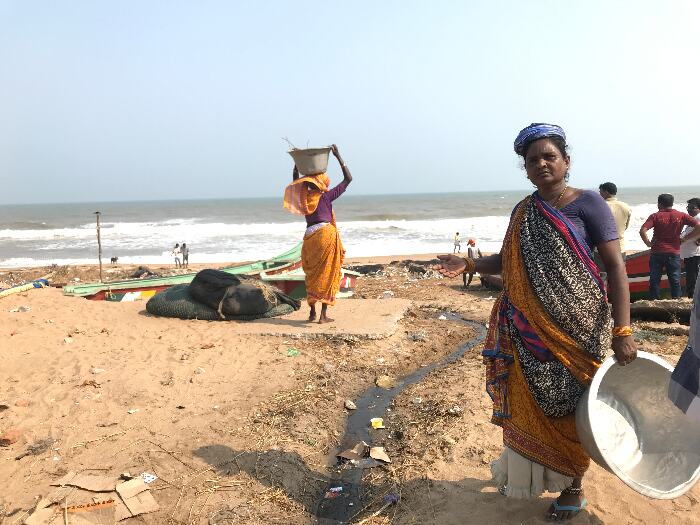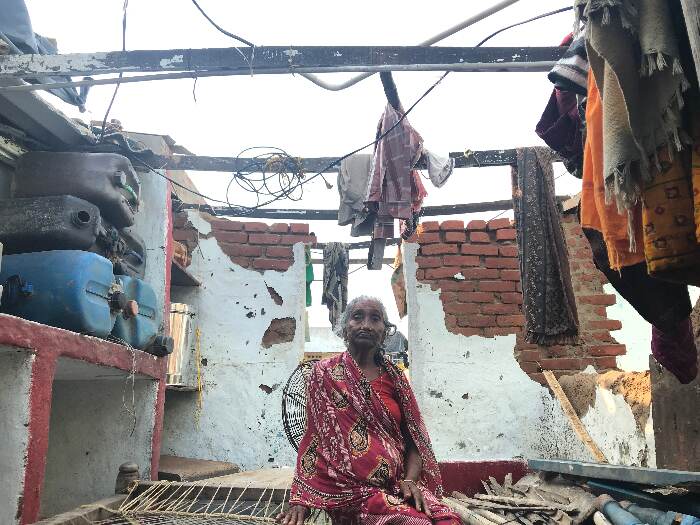Exactly three months back, on May 3 morning, Puri district in Odisha was hit by an extremely severe cyclonic storm Fani, which affected over 15 million people with at least 64 dead. The high speed winds of Fani, touching about 200 kilometres per hour, battered the state causing large-scale destruction pegged at 100,000 crore. In spite of being a rare occurrence, as tropical storms don’t commonly form in April month and cyclone Fani occurred very close to the equator and moved a very long trajectory with a long life cycle, this natural disaster remained largely ignored.
Gaon Connection travelled to cyclone-hit villages and slums in coastal Odisha and reported on losses suffered by the state and the uprooted lives of poorest of the poor. As the state government implements a massive programme to rebuild lives and infrastructure post Fani, which may take a couple of years, here is a photo feature on impacts of cyclone Fani. It is also a reminder that in a changing climate and global warming, as oceans heat up, tropical cyclones are expected to get stronger. Disaster preparedness and building resilience in communities is crucial.
 35-year-old Kapila Behera, an ice-cream seller, was aware of the approaching cyclone, but never imagined the strength of Fani and stayed back in his bamboo and thatch roof hut in Harchandi basti in Puri, Odisha. His wife and three kids went off to a cyclone shelter. Behera claims he has seen ‘pralay’ and still can’t believe he did not die when Fani hit his hutment with full force and blew it away. Pic: Nidhi Jamwal
35-year-old Kapila Behera, an ice-cream seller, was aware of the approaching cyclone, but never imagined the strength of Fani and stayed back in his bamboo and thatch roof hut in Harchandi basti in Puri, Odisha. His wife and three kids went off to a cyclone shelter. Behera claims he has seen ‘pralay’ and still can’t believe he did not die when Fani hit his hutment with full force and blew it away. Pic: Nidhi Jamwal
 While Punya Chandra Sahoo’s wife and three daughters went away to a cement-and-brick house of a family friend, he stayed back in his bamboo and thatch roof hutment and grocery shop in Harchandi basti to guard his family belongings. In spite of braving several cyclones since his childhood, Sahoo claimed he had never seen anything like Fani before. Pic: Nidhi Jamwal
While Punya Chandra Sahoo’s wife and three daughters went away to a cement-and-brick house of a family friend, he stayed back in his bamboo and thatch roof hutment and grocery shop in Harchandi basti to guard his family belongings. In spite of braving several cyclones since his childhood, Sahoo claimed he had never seen anything like Fani before. Pic: Nidhi Jamwal
 Sanjukta Behera and her three young children spent the day and night when cyclone Fani hit Odisha on May 3 at a cyclone shelter near Harchandi basti in Puri. The door of the cyclone shelter was broken and her children were soaked to the bone, crying, and clinging with her. It was a nightmare, which still haunts her. Pic: Nidhi Jamwal
Sanjukta Behera and her three young children spent the day and night when cyclone Fani hit Odisha on May 3 at a cyclone shelter near Harchandi basti in Puri. The door of the cyclone shelter was broken and her children were soaked to the bone, crying, and clinging with her. It was a nightmare, which still haunts her. Pic: Nidhi Jamwal
 The high speed winds of cyclone Fani pulverised all the houses in Harchandi basti, an urban slum in Puri, Odisha. Except lives, people have lost everything. Pic: Nidhi Jamwal
The high speed winds of cyclone Fani pulverised all the houses in Harchandi basti, an urban slum in Puri, Odisha. Except lives, people have lost everything. Pic: Nidhi Jamwal
 Post cyclone Fani, this was a common sight across Puri where high-speed winds of Fani blew away everything that came into its way. Pic: Nidhi Jamwal
Post cyclone Fani, this was a common sight across Puri where high-speed winds of Fani blew away everything that came into its way. Pic: Nidhi Jamwal
 Cyclone Fani plunged coastal parts of Odisha into darkness. Puri remained without power for almost a month, as Fani uprooted electric poles and mangled the power transmission towers. Workers from neighbouring states were brought in to restore power supply in phases. Pic: Nidhi Jamwal
Cyclone Fani plunged coastal parts of Odisha into darkness. Puri remained without power for almost a month, as Fani uprooted electric poles and mangled the power transmission towers. Workers from neighbouring states were brought in to restore power supply in phases. Pic: Nidhi Jamwal
 The strength of Cyclone Fani can be gauged from the destruction it left behind. An uprooted mobile phone tower in Paintakota, Puri. Pic: Nidhi Jamwal
The strength of Cyclone Fani can be gauged from the destruction it left behind. An uprooted mobile phone tower in Paintakota, Puri. Pic: Nidhi Jamwal
 All that is left of home of Suchismita Sahoo in Harchandi basti, Puri. Cyclone Fani destroyed lives of poorest of the poor in Odisha. Pic: Nidhi Jamwal
All that is left of home of Suchismita Sahoo in Harchandi basti, Puri. Cyclone Fani destroyed lives of poorest of the poor in Odisha. Pic: Nidhi Jamwal
 Local people allege that post cyclone Fani, the government was nowhere to be found in the initial two to three days. It was community kitchens run by local NGOs that kept the cyclone-hit people alive. A community kitchen in Paintakota, Puri run by SEEDS India. Pic: Nidhi Jamwal
Local people allege that post cyclone Fani, the government was nowhere to be found in the initial two to three days. It was community kitchens run by local NGOs that kept the cyclone-hit people alive. A community kitchen in Paintakota, Puri run by SEEDS India. Pic: Nidhi Jamwal
 Telagu fisher community is living in Paintakota urban slum in Puri for generations and has braved several cyclones. But, cyclone Fani has shocked them. These fishers were the first ones to hit by the high-speed winds of Fani on May 3. They have lost their boats, fishing nets and houses. Pic: Nidhi Jamwal
Telagu fisher community is living in Paintakota urban slum in Puri for generations and has braved several cyclones. But, cyclone Fani has shocked them. These fishers were the first ones to hit by the high-speed winds of Fani on May 3. They have lost their boats, fishing nets and houses. Pic: Nidhi Jamwal
 A ‘home’ of a fisherwoman in Paintakota, Puri. Pic: Nidhi Jamwal
A ‘home’ of a fisherwoman in Paintakota, Puri. Pic: Nidhi Jamwal
 Cyclone Fani left behind a trail of destruction and debris in Paintakota marine fishers slum in Puri. Pic: Nidhi Jamwal
Cyclone Fani left behind a trail of destruction and debris in Paintakota marine fishers slum in Puri. Pic: Nidhi Jamwal
 Cyclone Fani destroyed water supply schemes and several handpumps started spewing saline water. Safe drinking water had become a major challenge. Several villagers had no option but to drink saline water of hamdpumps. Pic: Nidhi Jamwal
Cyclone Fani destroyed water supply schemes and several handpumps started spewing saline water. Safe drinking water had become a major challenge. Several villagers had no option but to drink saline water of hamdpumps. Pic: Nidhi Jamwal
 A number of small and marginal farmers are into cashew farming in coastal Odisha. Cyclone Fani uprooted cashew plantations and farmers suffered losses worth several lakh. Rameshwarpatna near Puri was one such affected village. Pic: Nidhi Jamwal.
A number of small and marginal farmers are into cashew farming in coastal Odisha. Cyclone Fani uprooted cashew plantations and farmers suffered losses worth several lakh. Rameshwarpatna near Puri was one such affected village. Pic: Nidhi Jamwal.
 All that was left of a church at Paintakota marine fishers slum in Puri. Pic: Nidhi Jamwal
All that was left of a church at Paintakota marine fishers slum in Puri. Pic: Nidhi Jamwal
 In spite of being badly affected by cyclone Fani, it was the local people who responded the first to disaster and started rebuilding their lives. Poorest of the poor are also highly resilient. Pic: Nidhi Jamwal
In spite of being badly affected by cyclone Fani, it was the local people who responded the first to disaster and started rebuilding their lives. Poorest of the poor are also highly resilient. Pic: Nidhi Jamwal
Read Also: Cyclone Fani adds to the woes of Kolho tribe village near Bhubaneswar
Read Also: ‘Cyclone Fani has pushed us into the dark ages’
Read Also: A cyclone robbed my kaju katli: Farmers in leading cashew producer Odisha pummelled by Cyclone Fani




















